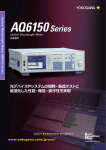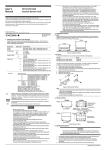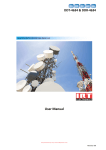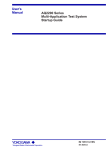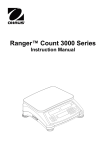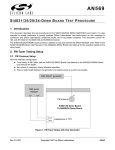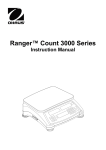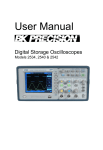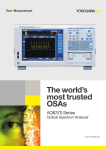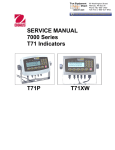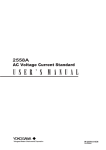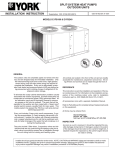Download AQ6150 Getting Statrted Guide - Electro
Transcript
User’s Manual AQ6150/AQ6151 Optical Wavelength Meter Getting Started Guide IM AQ6150-02EN 1st Edition Product Registration Thank you for purchasing YOKOGAWA products. YOKOGAWA provides registered users with a variety of information and services. Please allow us to serve you best by completing the product registration form accessible from our homepage. http://tmi.yokogawa.com/ PIM 103-03E Thank you for purchasing the AQ6150/AQ6151 Optical Wavelength Meter. The AQ6150/ AQ6151 is a high-speed wavelength measuring instrument for LD and LED light sources. This getting started guide primarily explains the handling precautions and basic operations of the AQ6150/AQ6151. To ensure correct use, please read this manual thoroughly before beginning operation. Keep this manual in a safe place for quick reference in the event that a question arises. The following manuals, including this one, are provided as manuals for the AQ6150/ AQ6151. Please read all manuals. AQ6150/AQ6151 Manual Title AQ6150/AQ6151 Optical Wavelength Meter User’s Manual AQ6150/AQ6151 Optical Wavelength Meter Getting Started Guide AQ6150/AQ6151 Optical Wavelength Meter Remote Control User’s Manual Manual No. Description IM AQ6150-01EN The manual explains all the AQ6150/ AQ6151 features other than the remote control features. IM AQ6150-02EN This guide. Provided as a printed manual. This guide explains the handling precautions, basic operations, and specifications of the AQ6150/AQ6151. IM AQ6150-17EN This manual explains the AQ6150/ AQ6151 communication interface features and how to use them. PDF files of all the manuals above are included in the accompanying CD. Notes Trademarks Revisions • The contents of this manual are subject to change without prior notice as a result of continuing improvements to the instrument’s performance and functionality. The figures given in this manual may differ from those that actually appear on your screen. • Every effort has been made in the preparation of this manual to ensure the accuracy of its contents. However, should you have any questions or find any errors, please contact your nearest YOKOGAWA dealer. • Copying or reproducing all or any part of the contents of this manual without the permission of YOKOGAWA is strictly prohibited. • Microsoft, Internet Explorer, MS-DOS, Windows, Windows NT, and Windows XP are either registered trademarks or trademarks of Microsoft Corporation in the United States and/or other countries. • Adobe and Acrobat are either registered trademarks or trademarks of Adobe Systems Incorporated. • In this manual, the TM and ® symbols do not accompany their respective registered trademark or trademark names. • Other company and product names are registered trademarks or trademarks of their respective holders. • 1st Edition: December 2012 1st Edition : December 2012 (YMI) All Rights Reserved, Copyright © 2012 Yokogawa Meters & Instruments Corporation IM AQ6150-02EN Checking the Contents of the Package Unpack the box and check the contents before operating the instrument. If the wrong items have been delivered, if items are missing, or if there is a problem with the appearance of the items, contact your nearest YOKOGAWA dealer. AQ6150/AQ6151 Check that the product that you received is what you ordered by referring to the model name and suffix code given on the name plate on the rear panel. When contacting the dealer from which you purchased the instrument, please give them the instrument number. MODEL AQ6150 AQ6151 Specifications Power cord1 SUFFIX -10 -D -F -Q -R -H -N Options /FC /SC Specifications Optical Wavelength Meter Optical Wavelength Meter Base model UL/CSA Standard power cord (Part No.: A1006WD) Maximum rated voltage: 125 V VDE Standard power cord (Part No.: A1009WD) Maximum rated voltage: 250 V BS Standard power cord (Part No.: A1054WD) Maximum rated voltage: 250 V AS Standard power cord (Part No.: A1024WD) Maximum rated voltage: 250 V GB Standard power cord (Part No.: A1064WD) Maximum rated voltage: 250 V NBR Standard power cord (Part No.: A1088WD) Maximum rated voltage: 250 V AQ9441 (FC) connector adapter2 AQ9441 (SC) connector adapter2 1 M ake sure that the attached power cord meets the designated standards of the country and area that you are using it in. 2 Already attached to the optical input of the AQ6150/AQ6151 front panel. No. (Instrument number) When contacting the dealer from which you purchased the instrument, please give them the instrument number. ii IM AQ6150-02EN Checking the Contents of the Package Standard Accessories The instrument is shipped with the following accessories. Make sure that all accessories are present and undamaged. Item Power cord* Rubber feet CD-ROM (user’s manuals) User’s manuals Model A1006WD A1009WD A1054WD A1024WD A1064WD A1088WD A9088ZM B8091YA IM AQ6150-02EN IM AQ6150-92Z1 Quantity 1 1 1 1 1 Specifications UL, CSA, and PSE standard VDE standard BS standard AS standard GB standard NBR standard — Contains PDFs of the user’s manuals This guide. The user’s manual for China Power cord (one cord that matches the suffix code is included)* UL/CSA Standard A1006WD D Rubber feet A9088ZM VDE Standard A1009WD BS Standard A1054WD AS Standard A1024WD GB Standard A1064WD R H Q F NBR Standard A1088WD N One set of manuals * M ake sure that the attached power cord meets the designated standards of the country and area that you are using it in. CD-ROM (User’s Manuals) The CD-ROM contains PDF files of the following manuals. To view these user’s manuals, you need Adobe Reader 5.0 or later. WARNING Never play this CD-ROM, which contains the user’s manuals, in an audio CD player. Doing so may cause loss of hearing or speaker damage due to the large sounds that may be produced. English • • • IM AQ6150-02EN AQ6150/AQ6151 Optical Wavelength Meter User’s Manual IM AQ6150-01EN AQ6150/AQ6151 Optical Wavelength Meter Getting Started Guide IM AQ6150-02EN AQ6150/AQ6151 Optical Wavelength Meter Remote Control User’s Manual IM AQ6150-17EN iii Checking the Contents of the Package Optional Accessories (Sold separately) The following optional accessories are available for purchase separately. For information about ordering accessories, contact your nearest YOKOGAWA dealer. Item AQ9441 Connector Adapter iv Model 813917321-FCC 813917321-SCC Min. Q’ty 1 1 Specifications FC type SC type IM AQ6150-02EN Safety Precautions This instrument is an IEC safety class I instrument (provided with a terminal for protective earth grounding). The general safety precautions described herein must be observed during all phases of operation. If the instrument is used in a manner not specified in this manual, the protection provided by the instrument may be impaired. YOKOGAWA assumes no liability for the customer’s failure to comply with these requirements. The following symbols are used on this instrument. Warning: handle with care. Refer to the user’s manual or service manual. This symbol appears on dangerous locations on the instrument which require special instructions for proper handling or use. The same symbol appears in the corresponding place in the manual to identify those instructions. Alternating current ON (power) OFF (power) IM AQ6150-02EN Safety Precautions Failure to comply with the precautions below could lead to injury or death or damage to the instrument. WARNING Use the Instrument Only for Its Intended Purpose This optical measuring instrument is designed to measure the optical characteristics of light sources and evaluate their performance. Do not use this instrument for anything other than as an optical measuring instrument. Check the Physical Appearance Do not use the instrument if there is a problem with its physical appearance. Use the Correct Power Supply Make sure that the power supply voltage matches the instrument’s rated supply voltage and that it does not exceed the maximum voltage range specified for the power cord. Use the Correct Power Cord and Plug To prevent the possibility of electric shock or fire, be sure to use the power cord supplied by YOKOGAWA. The main power plug must be plugged into an outlet with a protective earth terminal. Do not invalidate this protection by using an extension cord without protective earth grounding. Additionally, do not use the power cord supplied with this instrument with another instrument. Connect the Protective Grounding Terminal Be sure to connect the protective earth to prevent electric shock before turning ON the power. The power cord that comes with the instrument is a three-prong type power cord. Connect the power cord to a properly grounded three-prong outlet. Do Not Impair the Protective Grounding Never cut off the internal or external protective earth wire or disconnect the wiring of the protective earth terminal. Doing so may result in electric shock or damage to the instrument. Do Not Operate with Defective Protective Grounding or Fuses Do not operate the instrument if the protective earth or fuse might be defective. Check the grounding and the fuse before operating the instrument. Do Not Operate in an Explosive Atmosphere Do not operate the instrument in the presence of flammable gasses or vapors. Doing so is extremely dangerous. Do Not Remove Covers Only qualified YOKOGAWA personnel should remove the instrument’s covers. The inside of the instrument is dangerous because parts of it have high voltages. Install or Use the Instrument in Appropriate Locations • Do not install or use the instrument outdoors or in locations subject to rain or water. • Install the instrument so that you can immediately remove the power cord if an abnormal or dangerous condition occurs. vi IM AQ6150-02EN Safety Precautions CAUTION Operating Environment Limitations This product is a Class A (for industrial environments) product. Operation of this product in a residential area may cause radio interference in which case the user will be required to correct the interference. Safety Precautions for Laser Products This instrument uses a laser light source. This instrument is a Class 1 laser product as defined by IEC60825-1 Safety of Laser Products—Part1: Equipment Classification, Requirements and User’s Guide. In addition, this instrument complies with 21 CFR 1040.10 and 1040.11 except for deviations pursuant to Laser Notice No. 50, dated June 24, 2007. IM AQ6150-02EN vii Waste Electrical and Electronic Equipment Waste Electrical and Electronic Equipment (WEEE), DIRECTIVE 2002/96/EC (This directive is valid only in the EU.) This product complies with the WEEE Directive (2002/96/EC) marking requirement. This marking indicates that you must not discard this electrical/ electronic product in domestic household waste. Product Category With reference to the equipment types in the WEEE directive Annex I, this product is classified as a “Monitoring and control instruments” product. Do not dispose in domestic household waste. When disposing products in the EU, contact your local Yokogawa Europe B. V. office. New EU Battery Directive viii New EU Battery Directive, DIRECTIVE 2006/66/EC (This directive is valid only in the EU.) Batteries are included in this product. This marking indicates they shall be sorted out and collected as ordained in ANNEX II in DIRECTIVE 2006/66/EC. Battery type: Lithium battery You cannot replace batteries by yourself. When you need to replace batteries, contact your local Yokogawa Europe B.V.office. IM AQ6150-02EN Conventions Used in This Manual Notes The notes and cautions in this manual are categorized using the following symbols. Improper handling or use can lead to injury to the user or damage to the instrument. This symbol appears on the instrument to indicate that the user must refer to the user’s manual for special instructions. The same symbol appears in the corresponding place in the user’s manual to identify those instructions. In the user’s manual, the symbol is used in conjunction with the word “WARNING” or “CAUTION.” WARNING Calls attention to actions or conditions that could cause serious or fatal injury to the user, and precautions that can be taken to prevent such occurrences. CAUTION Calls attention to actions or conditions that could cause light injury to the user or cause damage to the instrument or user’s data, and precautions that can be taken to prevent such occurrences. Note Calls attention to information that is important for the proper operation of the software. Notations Used in the Procedural Explanations The contents of the procedural explanations are indicated using the following symbols, notations, and terminology. Procedure Carry out the procedure according to the step numbers. All procedures are written under the assumption that you are starting operation at the beginning of the procedure, so you may not need to carry out all the steps in a procedure when you are changing the settings. Explanation This section describes the setup items and the limitations regarding the procedures. Characters and Terminology Used in Procedural Explanations Panel Keys and Soft Keys Bold alphanumeric characters in procedural explanations indicate panel keys that are used in the procedure and soft keys and menu items that appear on the screen. Unit IM AQ6150-02EN k Denotes 1000. Example: 12 kg, 100 kHz K Denotes 1024. Example: 459 KB (file size) ix Contents 1 Checking the Contents of the Package............................................................................................. ii Safety Precautions.............................................................................................................................v Waste Electrical and Electronic Equipment.................................................................................... viii Conventions Used in This Manual.................................................................................................... ix 3 Chapter 1 Component Names and Functions 1.1 1.2 1.3 1.4 Front Panel........................................................................................................................ 1-1 Rear Panel........................................................................................................................ 1-2 Keys.................................................................................................................................. 1-3 Screens............................................................................................................................. 1-5 Chapter 2 Making Preparations for Measurements 2.1 2.2 2.3 2.4 2.5 2.6 2.7 2.8 Handling Precautions........................................................................................................ 2-1 Installing the AQ6150/AQ6151.......................................................................................... 2-2 Connecting to the Power Supply and Turning the Power Switch On and Off.................... 2-4 Attaching a Connector Adapter......................................................................................... 2-8 Connecting a Mouse, Keyboard, USB Storage Device................................................... 2-10 Connecting an Optical Fiber............................................................................................ 2-12 Setting the Clock............................................................................................................. 2-14 Recommended Part Replacement.................................................................................. 2-15 Chapter 3 Key Operations and Entering Values and Character Strings 3.1 3.2 3.3 Soft Key Description.......................................................................................................... 3-1 Mouse and Keyboard Operation....................................................................................... 3-3 Entering Values and Character Strings............................................................................. 3-4 Chapter 4 Specifications 4.1 4.2 Optical and General Specifications................................................................................... 4-1 External Dimensions......................................................................................................... 4-3 Index IM AQ6150-02EN 2 xi 4 Index Chapter 1 1.1 Component Names and Functions Front Panel 1 Component Names and Functions 2 Display Displays measured waveforms, measurement conditions, measured values, etc. Soft key section Control the functions that are assigned to soft keys, which appear on the right of the LCD display. 3 FUNCTION section Set all features including measurement, setup, and display. 4 DATA ENTRY section Enter measurement condition parameters and labels. Index POWER OPTICAL INPUT Connect the optical input signal here. PRT SCN key Saves a screen capture LOCAL key Clears remote mode REF LASER STATUS LED Indicates the internal reference light source status POWER switch A switch for starting and stopping the AQ6150/AQ6151 USB port Connect a USB storage medium, USB mouse, or USB keyboard. IM AQ6150-02EN 1-1 1.2 Rear Panel GP-IB connector Use this connector to control the AQ6150/AQ6151 from a PC. Power inlet Connect the power cord. ETHERNET port Use this port to connect the AQ6150/AQ6151 to a network. (10/100/1000BASE-TX) USB port Connect a USB storage medium, USB mouse, or USB keyboard. VIDEO OUT Video signal (VGA) terminal Use this terminal to view the AQ6150/AQ6151 screen on an external display. 1-2 IM AQ6150-02EN 1.3 Keys 1 The FUNCTION section consists of three measurement control keys, six function keys, and two auxiliary keys. Pressing a function key shows the setup parameters for the corresponding function in the setup menu at the upper right of the LCD screen. Measurement control keys Starts or stops measurement Starts repeat measurements. The key illuminates while the REPEAT measurement is in progress. Measurement is repeated until you press STOP. Starts a single measurement. The key illuminates while the SINGLE measurement is in progress. Measurement automatically stops after one measurement. STOP Stops the measurement. Internal reference light source status display Indicates the operating status of the internal He-Ne laser Off The laser is not being output. Measurement is not possible. Blinking orange Laser output is in preparation. This indicates the status until the laser output stabilizes. Measurement is not possible while the message “REF LASER STARTING” is displayed. If this status lasts approximately 5 minutes, the AQ6150/AQ6151 assumes that a malfunction has occurred and turns the LED red. When the AQ6150/AQ6151 is ready to measure, the message disappears. It takes approximately 1 minute for the laser output to stabilize. To make accurate measurements, wait for the laser output to stabilize. Green Normal status (stable laser output). Measurement is possible. Orange When the light source approaches its service life, the message “It is about time to plan for REF LASER replacement" appears. The operating time of the laser output has reached the replacement reference time (30,000 hours). Measurement is possible, but replace the light source quickly. Red If a malfunction occurs, the message “REF LASER or interferometer is out of order. Please contact our sales representatives” appears. Measurement is not possible. For information on replacing the light source, contact your nearest YOKOGAWA dealer. Auxiliary key See section 1.1. Remote control indicator Illuminates in remote control mode. See section 1.2 in the User’s Manual IM AQ6150-17EN. Function keys Set measurement conditions, data saving and loading, etc. DISPLAY Displays a setup menu for selecting measurement screens and setting waveform display scales SEARCH Displays a setup menu for searching measured peaks ANALYSIS Displays a setup menu for taking drift measurements and performing FP-LD analysis IM AQ6150-02EN SETUP Displays a setup menu for setting measurement conditions (type of light, detection threshold, unit, etc.) FILE Displays a setup menu for saving and loading measured data and settings from a USB storage device or internal memory SYSTEM Displays a setup menu for setting network parameters, showing system information, setting the clock, and so on 1-3 Component Names and Functions FUNCTION Section 2 3 4 Index 1.3 Keys DATA ENTRY Section You can enter various measurement parameters from the DATA ENTRY section. You can use arrow keys and the numeric keypad to enter parameters. COARSE key Turn this key on to select the next higher digit or increases the step by which the value changes. Each time you press the key, the setting toggles between on and off. When set to on, the key illuminates. Arrow keys Increase or decrease values, move the cursor (up and down) in file lists, move the cursor (up, down, left, and right) in the character selection area of character input screens, enter numeric keypad values (left and right), and so on. To increase a value: ▲ or ► key To decrease a value: ▼ or ◄ key BACK SPACE key Press this key to erase the key before the cursor. The last entered number (at the right end) is erased, and you can enter the correct number. If you press BACK SPACE repeatedly and the numeric keypad input area becomes empty, the numeric keypad input area disappears. ENTER key Confirms the value that you have entered with the numeric keypad, in the parameter input window, or character input screen. Numeric keypad You can use the numeric keypad to enter values directly in parameter input windows. If you press a soft key that has a parameter, the current value appears in a parameter value display area. If you press a key on the numeric keypad in this condition, the number that you selected appears in the area. If the value that you enter with the numeric keypad is outside the allowed range, it is reset to the closest value within the range. 1-4 IM AQ6150-02EN 1.4 Screens 1 Component Names and Functions 2 Main Screen Measurement result display Displays the peak window, peak list window, and spectrum window. The display varies depending on the VIEW mode. Details are given later. 3 Measurement summary Displays the number of detected peaks (PEAK), center wavelength (CTR WL), and total power (TOTAL PWR) Label You can display text of your choice using up to 52 characters. 4 Date and time Index Measurement parameter value input Numeric keypad screen If you connect a mouse to the AQ6150/AQ6151, you can perform the same operations that you can using the front panel’s numeric keypad. Setup menu Light type setting (Narrow or Broad) Peak detection threshold and excursion values Averaging count Measurement control keys Indicates the state of the measurement control keys. If you connect a mouse to the AQ6150/AQ6151, you can click these keys to perform the same operations that you can using the front panel’s measurement control keys. RPT: Repeat measurement SGL: Single measurement STP: Stop measurement The medium setting (vacuum or air) Illuminates when measurement wavelength range limit is on (see section 3.5) Illuminates when the power offset is not zero (see section 2.7 of the Getting Started Guide, IM AQ6150-02EN.) Illuminates when the auto peak search feature is on IM AQ6150-02EN 1-5 1.4 Screens Multi Peak Screen for Absolute Values For the operating procedure, see section 4.2 in the User’s Manual, IM AQ6150-01EN. Current peak number/the number of detected peaks Indicates which peak among the detected peaks is shown in the peak window. Example: 10th peak among the 32 peaks detected Wavelength The wavelength of the current peak Peak value Indicates that the current peak is the maximum (power) Power bar The ratio of the power value Power The power the current peak Peak window Peak list window A list of detected peaks Power bar Ratio of the power of each peak relative to the maximum measurable power Power The power of each peak Wavelength The wavelength of each peak Number Numbers automatically assigned to all detected peaks Cursor display Move the cursor to select the peak (current peak) to show in the peak window. Multi Peak Screen for Relative Values The peak window is the same as in the multi peak screen for absolute values, which is shown above. For the operating procedure, see section 4.3 in the User’s Manual, IM AQ6150-01EN. ΔWL Wavelength relative to the reference (REF) peak ΔPW Power relative to the reference (REF) peak 1-6 IM AQ6150-02EN 1.4 Screens 1 Single Peak Screen Component Names and Functions Only the peak window is displayed. The displayed contents and features are the same as those of the multi peak screens. For the operating procedure, see section 4.1 in the User’s Manual, IM AQ6150-01EN. 2 3 4 Index Spectrum Window For the operating procedure, see section 4.4 in the User’s Manual, IM AQ6150-01EN. Scale Displays a power scale of absolute values Threshold The peak detection threshold. If the threshold is specified with a relative value, it is converted to an absolute value and displayed. Moving marker (▼) This marker appears on the current peak. The marker is filled with a color. Fixed marker ( ) A numbered marker that is automatically assigned during peak detection The maximum number is 1024. Overview window The entire spectrum waveform Start wavelength of the scale The start wavelength of the display range Zoom Appears when the spectrum is being zoomed in on IM AQ6150-02EN Stop wavelength of the scale The stop wavelength of the display range Wavelength per division Center wavelength of the scale The center wavelength of the display range 1-7 Chapter 2 Making Preparations for Measurements 2.1 Handling Precautions 1 Safety Precautions 3 Do Not Remove the Case Do not remove the case from the instrument. Some sections inside the instrument have high voltages that are extremely dangerous. For internal inspection and adjustment, contact your nearest YOKOGAWA dealer. Unplug If Abnormal Behavior Occurs If you notice smoke or unusual odors coming from the instrument, immediately turn off the power and unplug the power cord. Then, contact your nearest YOKOGAWA dealer. Do Not Damage the Power Cord Nothing should be placed on top of the power cord, and it should be kept away from any heat sources. When removing the plug from the power outlet, do not pull on the cord. Pull from the plug. If the power cord is damaged, contact your nearest YOKOGAWA dealer. Refer to page iii for the part number when placing an order. General Handling Precautions Do Not Place Objects on Top of the Instrument Never place objects such as other instruments or objects that contain water on top of the instrument. Doing so may damage the instrument. Do Not Damage the LCD Because the LCD is very vulnerable and can be easily scratched, do not allow any sharp objects near it. When Carrying the Instrument Be sure to turn off the power switch and remove the power cord and other connected cables before carrying the instrument. As indicated in the following figure, use both hands to firmly hold the handles when carrying the instrument. When Cleaning the Instrument When cleaning the case or the operation panel, first remove the power cord from the outlet, and then wipe with a dry, soft, clean cloth. Do not use chemicals such as benzene or thinner. Doing so may cause discoloring and deformation. IM AQ6150-02EN 2 Making Preparations for Measurements If you are using this instrument for the first time, make sure to read “Safety Precautions” on pages v to vii. 2-1 4 Index 2.2 Installing the AQ6150/AQ6151 WARNING • Do not install the instrument outdoors or in locations subject to rain or water. • Install the instrument so that you can immediately remove the power cord if an abnormal or dangerous condition occurs. CAUTION • If you block the inlet holes on the bottom or the exhaust holes on the rear side of the instrument, the instrument will become hot and may break down. Also, high temperatures may shorten the service life of the internal reference light source (He-Ne laser). • Do not place this instrument on top of another device that is emitting heat. If heat enters through the inlet holes on the bottom of the instrument, the instrument will become hot and may break down. Installation Conditions Install the instrument in a place that meets the following conditions. Well-Ventilated Location There are inlet holes on the bottom side of the instrument. There are also exhaust holes on the rear side. To prevent internal overheating, allow for enough space around the instrument (see the figure below), and do not block the inlet and exhaust holes. 20 cm or more When connecting cables, allow for enough space, above and beyond the space shown in the figure above, to carry out the procedure. Ambient Temperature and Humidity Ambient temperature Ambient humidity 5 to 35 °C 20 to 85% RH (no condensation) Note Condensation may form when moving the instrument from a low temperature or humidity environment to a high temperature or humidity environment, or when there is a sudden change in temperature. In such cases, before you use the instrument, allow it to adjust to the ambient temperature. If you transport the instrument in its packing box, to prevent condensation, allow it to adjust to the new ambient temperature before taking it out of the box. Flat, Even Surface Install the instrument on a stable surface that is level in all directions and that is not slippery. If you use the instrument in an unstable location or on a slippery surface, the instrument may fall off its platform or hit other devices due to the vibration that the instrument produces during operation. If the instrument is installed in a horizontal position, the supplied rubber stoppers can be attached to the feet at the rear of the instrument to prevent the instrument from sliding. 2-2 IM AQ6150-02EN 2.2 Installing the Instrument 1 Rubber foot A9088ZM Foot at the rear of the bottom of the instrument 2 To rack-mount the instrument, use the separately sold rack mount kit. Item Model 751535-E3 Model 751535-J3 Model Rack mount kit (for mounting one AQ6150/AQ6151 on 751535-E3 an EIA standard rack) Rack mount kit (for mounting one AQ6150/AQ6151 on 751535-J3 a JIS standard rack) 4 An outline of the mounting procedure is given below. For detailed instructions, see the manual that is included with the rack mount kit. 1. Remove the handles from both sides of the instrument. 2. Remove the four feet from the bottom of the instrument. 3. Remove the four seals covering the rack mount attachment holes. The holes are on the sides of the instrument near the front. 4. Place seals over the feet and handle attachment holes. 5. Attach the rack mount kit to the instrument. 6. Mount the instrument on a rack. How to remove a handle cover Note • When rack-mounting the instrument, allow at least 5 cm of space around the bottom panel inlet holes to prevent internal heating. Allow at least 20 cm around the rear panel exhaust holes. • Make sure to provide adequate support from the bottom of the instrument. The support should not block the inlet and vent holes. • Store the removed parts in a safe place. • When rack-mounting the instrument, remove the feet from the rear of the instrument if they are coming into contact with the rack and are thus preventing you from rack-mounting the instrument. After you have rack-mounted the instrument, re-attach the feet to the rear of the instrument. In this case, be sure to attach the brackets to the instrument before you remove the feet from the rear of the instrument. If you don’t, the instrument’s cover may come loose and fall when you rack-mount the instrument. Do Not Install the Instrument in the Following Kinds of Places • In a location where flammable or explosive gasses, steam, or dust is present or a location in which explosion or fire may occur (dangerous location) • In direct sunlight or near heat sources • In an environment with excessive amounts of soot, steam, dust, or corrosive gas • In an environment that is subject to large levels of mechanical vibration • On an unstable surface • Outdoors or in locations subject to rain or water IM AQ6150-02EN Making Preparations for Measurements 3 Rack Mounting 2-3 Index 2.3 Connecting to the Power Supply and Turning the Power Switch On and Off Before Connecting the Power Supply Make sure to follow the warnings below when connecting the power supply. Failure to do so may cause electric shock or damage to the instrument. WARNING • Make sure that the power supply voltage matches the instrument’s rated supply voltage and that it does not exceed the maximum voltage range specified for the power cord. • Connect the power cord after checking that the main power switch of the instrument is turned off. • To prevent electric shock or fire, be sure to use the power cord for the instrument that is supplied by YOKOGAWA. • Make sure to connect protective earth grounding to prevent electric shock. Connect the power cord to a three-prong power outlet with a protective earth terminal. • Do not use an ungrounded extension cord. If you do, the instrument will not be grounded. • If an AC outlet that conforms to the supplied power cord is unavailable and you cannot ground the instrument, do not use the instrument. Connecting the Power Cord 1. Check that the MAIN POWER switch on the rear panel is off. 2. Connect the power cord plug to the power inlet on the rear panel. 3. Connect the other end of the cord to an outlet that meets the following conditions. Use a grounded three-prong outlet. Item Rated supply voltage* Permitted supply voltage range Rated power supply frequency Permitted supply frequency range Maximum power consumption 100 VAC to 240 VAC 90 VAC to 264 VAC 50/60 Hz 48 Hz to 63 Hz Approx. 150 VA *This instrument can use a 100 V or a 200 V power supply. The maximum rated voltage differs according to the type of power cord. Before you use the instrument, check that the voltage supplied to it is less than or equal to the maximum rated voltage of the power cord provided with it (see page iii for the maximum voltage rating). Three-prong outlet MAI ON OF F N PO WER Power cord (accessory) 2-4 10 015 24 0V FU A 0V SE MA AC 25 X 0V 50 T /6 0H 5A z IM AQ6150-02EN 2.3 Connecting to the Power Supply 1 CAUTION 2 Making Preparations for Measurements • When turning the power on, do not apply a high-output light source to the instrument. If you do, the optical section may be damaged. • Do not operate the POWER or MAIN POWER switch during the initialization process. Doing so may damage the AQ6150/AQ6151. 3 Turning the Main Power Switch On 1. Flip the MAIN POWER switch on the rear panel to the ON ( | ) position. 4 The POWER switch on the front panel illuminates in orange. MAI ON OF F N PO Index WER 10 015 24 0V FU A 0V SE MA AC 25 X 0V 50 T /6 0H 5A z Turning the POWER Switch On 2. Press the POWER switch on the front panel. The power switch color changes from orange to green. The operating system starts, and the AQ6150/ AQ6151 starts initialization. Operations Performed When the Power Is Turned On When you turn on the power, an initialization screen automatically appears, and the internal checkup, reference light source, initialization procedures, and other procedures start. The progress of initialization is indicated at the bottom of the screen with indications from “STEP 1/6” to “STEP 6/6.” When the initialization finishes normally, the measurement result screen appears. When the Power-on Operation Does Not Finish Normally Turn off the power switch, and check that: • The instrument is installed properly. See section 2.2, “Installing the Instrument.” • The power cord is connected properly. See the previous page. If the instrument still does not work properly, contact your nearest YOKOGAWA dealer for repairs. If an error occurs in the memory or some other part of the instrument during initialization, the AQ6150/AQ6151 will stop running with “STEP @/6”showing on the screen (where @ is a number between 1 and 6). If this occurs, repairs are necessary. Contact your nearest YOKOGAWA dealer immediately. IM AQ6150-02EN 2-5 2.3 Connecting to the Power Supply Note The AQ6150/AQ6151 retains its current conditions such as which soft keys have been pressed. When you turn on the power, the AQ6150/AQ6151 returns to the conditions that it was in immediately before the power was turned off. The first time you turn on the power, the AQ6150/AQ6151 starts with its factory default conditions. Turning the POWER Switch Off CAUTION When the AQ6150/AQ6151 is running, do not turn off the power with the MAIN POWER switch on the rear panel. If you do, the operating system configuration file will not be backed up, and the AQ6150/AQ6151 may be unable to start normally the next time you start it. Also, the operation of the internal interferometer may be impeded. Be sure to follow the procedure below to turn off the power switch. 1. Press the POWER switch on the AQ6150/AQ6151 front panel. A shutdown confirmation screen and YES and NO soft keys appear. 2. Press the YES soft key. The message “AQ6150 is shutting down Please wait.....” appears, and the shutdown procedure begins. If you do not want to shut down, press the NO soft key. The previous setup menu will return. 3. After the POWER switch changes from green to orange, flip the MAIN POWER switch on the rear panel to the “O OFF” position. You can also use the panel keys and soft keys to shut the AQ6150/AQ6151 down. 1. Press SYSTEM. System configuration setup menu appears. 2. Press the MORE 1/2 soft key. 3. Press the SHUT DOWN soft key. A shutdown confirmation screen and YES and NO soft keys appear. 4. Press the YES soft key. The shutdown procedure begins. Executes shutdown Cancels shutdown Select SHUT DOWN. Shutdown confirmation message MORE 1/2 2-6 IM AQ6150-02EN 2.3 Connecting to the Power Supply 5. After the POWER switch changes from green to orange, flip the MAIN POWER switch on the rear panel to the “O OFF” position. Note 2 Making Preparations for Measurements If, for some reason, you cannot shut down the AQ6150/AQ6151 normally, you can hold the POWER switch down for approximately 4 seconds to force the AQ6150/AQ6151 into standby mode. The next time you start the AQ6150/AQ6151, the following message will appear. Press any key to clear this message. The unit was not shutdown properly. This might cause a hardware problem. Please follow the shutdown procedure described in the manual. If you perform this operation, the operating system configuration file will not be backed up, and the AQ6150/ AQ6151 may be unable to start normally. 1 3 4 Index IM AQ6150-02EN 2-7 2.4 Attaching a Connector Adapter Before using the AQ6150/AQ6151, attach an AQ9441 connector adapter, which is sold separately, to the AQ6150/AQ6151. CAUTION • When attaching or detaching a connector adapter, be sure not to damage the ferrule end face. Keep the connector adapter perpendicular with the ferrule and slowly insert or remove the adapter. • If you shake the connector adapter to the left and right or force it into the connector, the ferrule or connector adapter may be damaged. • Do not blow air into the OPTICAL INPUT. Doing so may cause dust and other foreign particles to enter the interferometer and degrade its performance. Note On models with the /FC option or /SC option, the connector adapter comes attached to the optical input of the AQ6150/AQ6151 front panel. Procedure Attachment Procedure 1. Check that the AQ6150/AQ6151 is turned off. 2. Open the optical connector cover on the AQ6150/AQ6151 front panel. 3. Clean the ferrule end of the optical input using a cotton swab moistened with a small amount of absolute alcohol. 4. Insert the connector adapter straight into the connector. 5. Press the connector adapter’s lock lever down. The connector adapter is attached properly if the optical input’s latch pins engage with the lock lever grooves. Removal Procedure 1. Check that the AQ6150/AQ6151 is turned off. 2. Turn the connector adapter’s lock lever up. The lock lever lock will disengage. 3. Pull the connector adapter straight from the connector. 4. Close the optical connector cover. Optical input Connector adapter Ferrule Lock lever Panel 2-8 Latch pin Attached IM AQ6150-02EN 2.4 Attaching a Connector Adapter 1 Explanation Connector Adapter Types The connector adapter comes in two types. 2 Making Preparations for Measurements FC 3 SC Optical Connector Shapes 4 The optical connectors that you can use with the AQ6150/AQ6151 are the FC and SC types. Cap FC optical connector IM AQ6150-02EN Index Cap SC optical connector 2-9 2.5 Connecting a Mouse, Keyboard, USB Storage Device Connecting a Mouse Compatible Mouse Devices You can use mouse devices (with wheels) that are compliant with USB HID Class Version 1.1. Connection Procedure Connect a USB mouse to a USB port on the front or rear panel of the AQ6150/AQ6151. Align the connector orientation with the port, and insert the connector straight into the port. Note • There are two USB ports on the front panel and two USB ports on the rear panel, but do not connect more than one mouse to the AQ6150/AQ6151. • For instructions on how to use the mouse, see section 3.2. Connecting a Keyboard You can connect a keyboard to the AQ6150/AQ6151 and use it to enter file names, comments, and other items. The AQ6150/AQ6151 features and settings are mapped to the keys on the keyboard, so you can use the keyboard to perform the same operations that you can perform using the AQ6150/ AQ6151 panel keys. Compatible Keyboards You can use a US 101 key USB keyboard. Connection Procedure Connect a USB keyboard to a USB port on the front or rear panel of the AQ6150/AQ6151. Align the connector orientation with the port, and insert the connector straight into the port. Note • There are two USB ports on the front panel and two USB ports on the rear panel, but do not connect more than one keyboard to the AQ6150/AQ6151. • For instructions on how to use the keyboard, see section 3.2. 2-10 IM AQ6150-02EN 2.5 Connecting a Mouse, Keyboard, USB Storage Device Connecting a USB Storage Device 1 The AQ6150/AQ6151 supports USB memory devices and hard drives compliant with USB 1.0 or USB 2.0. For more details, contact your nearest YOKOGAWA dealer. 2 Compatible USB Storage Media Removal Procedure 3 4 Be sure to follow the procedure below to remove a USB storage medium. 1. Press FILE. A file menu appears. Check whether the REMOVE USB STORAGE soft key is unavailable (dimmed). If it is, the USB storage medium can be removed. 2. If not (the REMOVE USB STORAGE soft key is available), press it. The REMOVE USB STORAGE soft key becomes unavailable (dimmed), and the USB storage medium can be removed. Removes the USB storage medium Note • If there are multiple connected USB storage devices, the AQ6150/AQ6151 detects only the one connected first. If there is a USB storage device already connected and you connect another, the AQ6150/AQ6151 will not detect it. If you remove the USB storage device that was connected first, the AQ6150/AQ6151 will not automatically detect the other one. If you want the AQ6150/AQ6151 to detect the other device, disconnect it once and reconnect it. • For other notes, see the instruction manual supplied with the USB memory device. IM AQ6150-02EN Making Preparations for Measurements Connection Procedure Connect a USB memory device to a USB port on the front or rear panel of the AQ6150/AQ6151. Align the connector orientation with the port, and insert the connector straight into the port. 2-11 Index 2.6 Connecting an Optical Fiber Connecting an Optical Fiber WARNING • Do not look at the optical fiber laser light that you are measuring or point the laser at another person’s eye. Doing so may cause eye damage or impair one’s health. • Do not apply light that is +18 dBm or greater to the optical connector of the AQ6150/ AQ6151. Doing so may damage the optical components that are used inside the AQ6150/ AQ6151. • Connect the optical fiber after starting the AQ6150/AQ6151. Applying high-intensity light when the AQ6150/AQ6151 is starting can damage the optical components that are used inside it. • Clean the connector end face of the optical fiber under measurement before connecting it to the AQ6150/AQ6151. If dust is adhered to the connector end face, it may damage the AQ6150/AQ6151 optical connector. Cleaning the Optical Fiber End Face 1. Firmly press the connector end face of the optical fiber against the cleaning surface of the cleaner. 2. While pressing the end face against the cleaner, turn it once. 3. While pressing the end face against the cleaner, move it. 4. Repeat steps 1 to 3. Note • If you do not firmly press the connector end face of the optical fiber against the cleaner, the end face may not be cleaned completely. • You can purchase an optical fiber connector cleaner from NTT-AT Corporation. • The AQ6150/AQ6151 does not have a laser light output section, but light that is 1 nW or less in strength will leak from the front panel optical input (OPTICAL INPUT). This light is extremely weak, so there is no need to take safety measures. The AQ6150/AQ6151 does not emit harmful radiation during operation. Optical input 2-12 IM AQ6150-02EN 2.6 Connecting an Optical Fiber 1 Connecting a Light Source, Optical Attenuator, or Optical Amplifier If you want to connect an optical attenuator or amplifier, insert it between the AQ6150/AQ6151 and the light source. Light source Optical attenuator or amplifier Making Preparations for Measurements AQ6150/AQ6151 2 3 4 Optical fiber Optical fiber When Connecting an Optical Attenuator or Amplifier If the level of light from the light source is outside the input range of the AQ6150/AQ6151, connect an optical attenuator or amplifier to adjust the level to within the rated input range of the AQ6150/ AQ6151. In this case, set the power offset so that the power (optical input level) displayed on the AQ6150/AQ6151 matches the actual level. 1. Press SYSTEM. System condition setup menu appears. Set the power offset. 2. Press the POWER OFFSET soft key. The screen for setting the power offset appears. 3. Enter the power offset value using the arrow keys or numeric keypad. Enter a value. You do not have to enter a unit. 4. Press ENTER. The power offset value that you specified appears on the soft key. For details on the power values that the AQ6150/AQ6151 displays, see section 1.4. IM AQ6150-02EN 2-13 Index 2.7 Setting the Clock The AQ6150/AQ6151 displays the year, month, day, and time in the upper right of the screen. The time is used in timestamps when data is recorded. Displaying the Clock Setup Screen 1. Press SYSTEM. System configuration setup menu appears. 2. Press the MORE 1/2 soft key. 3 Press the SET CLOCK soft key. A setup menu and setup screen for setting the clock appear. Setting the Clock 4 Press the CURSOR soft key. The cursor in the clock input area of the setup screen moves. 5 Move the cursor to the value that you want to set, and press ENTER. The screen for setting the value appears. 6 Enter the value using the arrow keys or numeric keypad. Moves the cursor on the clock setup screen Set the clock. Cursor for setting the clock MORE 1/2 7 Press ENTER. The clock in the upper right of the screen will be updated. Finishing the Setup 8 Press the RETURN soft key. The setup menu returns to the previous display. 2-14 IM AQ6150-02EN 2.8 Recommended Part Replacement 1 Part Name LCD backlight Internal reference light source (He-Ne laser) Service Life Under normal conditions of use, approximately 50000 hours Under normal conditions of use, approximately 40000 hours The following are consumable parts. We recommend replacing them at the following intervals. For part replacement, contact your nearest YOKOGAWA dealer. Part Name Cooling fan Backup battery (lithium battery) Service Life 3 years 5 years 3 4 Index Replacement Period of the Internal Reference Light Source (He-Ne laser) When the reference time (approx. 30000 hours) for replacing the internal reference light source elapses, the REF LASER STATUS LED on the front panel changes color. For details, see section 1.3. You can view the total operating time of the internal reference light source. It is the total of the times when the output of the internal reference light source has been on. However, the light source may reach its service life earlier than the reference time. See the notes of caution in the following sections. • Section 2.2, “Installing the Instrument” •Section 7.4, “Turning the Internal Reference Light Source (He-Ne laser) On and Off” in the User’s Manual, IM AQ6150-01EN. Viewing the Total Operating Time of the Internal Reference Light Source 1. Press SYSTEM. System configuration setup menu appears. 2. Press the SYSTEM INFORMATION soft key. The system information appears. Displays system information Total operating time of the internal reference light source (He-Ne laser) IM AQ6150-02EN 2 Making Preparations for Measurements YOKOGAWA guarantees the AQ6150/AQ6151 for the period and under the conditions of the product warranty. Under the conditions of the warranty, the following parts are excluded. For part replacement, contact your nearest YOKOGAWA dealer. 2-15 Chapter 3 3.1 Key Operations and Entering Values and Character Strings Soft Key Description 1 When you press a function key, the contents of the setup menu, which appears in the right side of the screen, change. To help you understand how different soft keys work, the soft keys are displayed using different shapes that indicate their functions. Normal soft key 4 Press to execute the function of the soft key. There is a next level. Indicates that items related to the displayed item are available in the next level Press to display the soft keys of the next level. Displays a separate window Press to display a separate window for entering a parameter value. Displays the next level and a separate window Press to display the next level and a separate window. Soft key for returning to the previous level Press to return to the soft keys of the previous level. Selection soft key Select a soft key from among the soft keys that are connected by black bands. The selected soft key is highlighted. In some cases, several soft keys may be connected. IM AQ6150-02EN 3 Key Operations and Entering Values and Character Strings Shapes and Functionalities 2 3-1 Index 3.1 Soft Key Description Display Example SETUP 1/2 SETUP 2/2 The SETUP setup menu is divided into two sections. This key switches the menu. In some cases, this changes to a soft key for closing other windows. In this example, pressing the MORE1/2 soft key brings up the SETUP 2/2 setup menu, and the soft key changes to MORE2/2. Indicates the setup menu hierarchy. This example shows that a setup menu is available under DEVICE TYPE. (This is for indication only; it is not an actual soft key.) Note For the entire soft key hierarchy, see appendix 1 in the User’s Manual, IM AQ6150-01EN. 3-2 IM AQ6150-02EN 3.2 Mouse and Keyboard Operation 1 Mouse Operation You can connect a mouse and use it to perform the same operations that you can perform with the AQ6150/AQ6151 keys. Also, by clicking a menu item, you can perform the same operation that you can perform by pressing the menu item’s soft key. For details on connecting a mouse, see section 2.6. Displaying the Top Menu 4 REPEAT SINGLE STOP DISPLAY SEARCH ANALYSIS SETUP FILE SYSTEM LOCAL PRT SCREEN TEST MODE Index Selecting an Item Click the item that you want to select. The setup menu for the item appears. The list of front panel keys disappears. Before you click an item, if you click an area outside the front panel key list area, the list will disappear. Selecting a Function on the Setup menu Click the soft key that you want to select. The screen that would appear if you had pressed the soft key will appear. External Keyboard Operation The functions of the AQ6150/AQ6151 front panel keys are mapped to the keys on the keyboard, so you can use the keyboard to perform the same operations that you can perform using the AQ6150/ AQ6151 panel keys. For the panel key to keyboard key assignments, see the panel key assignment table below. You can use the keyboard to enter labels, file names, and values. Classification Function FUNCTION Display settings DISPLAY Analysis feature SEARCH ANALYSIS Measurement SETUP settings Other FILE SYSTEM Soft keys F1 to F7 Auxiliary key PRT SCREEN DATA ENTRY Numeric keypad BACK SPACE nm/ENTER Arrow keys (▲▼◄►) COARSE IM AQ6150-02EN 3 Key Operations and Entering Values and Character Strings Right-click on the display. Front panel keys in the AQ6150/AQ6151 FUNCTION section appear. 2 External Keyboard [SHIFT]+[F1] [SHIFT]+[F2] [SHIFT]+[F3] [SHIFT]+[F4] [SHIFT]+[F5] [SHIFT]+[F6} F1 to F7 [SHIFT]+[P] 0123456789.— Back space ENTER [↑], [↓], [←], [→] [ALT]+[N] Description Display settings Search feature FP-LD analysis and drift measurement settings Type of light, peak detection threshold, etc. File saving, loading, and operation System settings Varies depending on the menu Screen copy Numeric input Deletes one character Confirms the entry Increment or decrement values, change items, and scroll lists Switches coarse/fine encoder mode 3-3 3.3 Entering Values and Character Strings Entering Values Use the numeric keypad or arrow keys in the DATA ENTRY section. For a description of each key, see section 1.3. 1. Press a soft key that has a parameter. The current value appears in the measurement parameter input area. Using the Numeric Keypad 2. Press a numeric key. A numeric keypad input area appears, and the value that you selected appears. 3. After entering the value, press ENTER. The value in the numeric keypad input area is reflected in the parameter input window, which updates the parameter value. If you press the wrong key on the numeric keypad 4. Press BACK SPACE. The last number entered in the numeric keypad input area is erased, and you can enter the correct number. Note • If the value that you enter with the numeric keypad is outside the allowed range, it is reset to the closest allowed value. • If you press BACK SPACE repeatedly and the numeric keypad input area becomes empty, the numeric keypad input area disappears. Using the Arrow Keys 2. After step 1, press an arrow key. The current value changes. 3. Press COARSE to select the next higher digit or increase the step by which the value changes. Press it again to undo the operation. When COARSE is selected, the COARSE key illuminates. 3-4 IM AQ6150-02EN 3.3 Entering Values and Character Strings 1 Entering Character Strings To enter character strings, you can use the soft keys in the character selection area that appears on the screen. An example of how to enter a label is shown below. 1. Press DISPLAY. 2 A display condition setup menu appears. 2. Press the MORE 1/2 soft key. 3 3. Press the LABEL soft key. Moves the cursor to the right in the character input area Moves the cursor to the left in the character input area Inserts a space at the cursor position Character input area Character selection area Deletes the character at the cursor position Deletes all characters in the character input area Confirms the characters that you have entered Discards the characters that you have entered 3. In the character selection area, move the cursor to the character that you want to enter. Use the arrow keys to move the cursor. 4. Press ENTER. The character that you select appears at the cursor in the character input area. 5. To move the cursor, insert a space, or delete a character in the character input area, press the corresponding soft key. 6. Press the DONE soft key. The entered character string is confirmed, and the entry is complete. Note • In addition to appearing when you press the DISPLAY key, the character string input screen also appears when you need to enter character strings, such as when you are entering the names of files you want to save. • You can enter numbers directly from the numeric keypad. • You can also use an external keyboard to enter values and character strings. For details on connecting an external keyboard, see section 2.5. IM AQ6150-02EN 3-5 Key Operations and Entering Values and Character Strings A setup menu and a character input screen for entering characters appear. 4 Index Chapter 4 4.1 Specifications Optical and General Specifications 1 Item IM AQ6150-02EN 4-1 2 3 4 Specifications Specifications Model: AQ6150 Model: AQ6151 Applicable optical fiber SM (ITU-T G.652) Wavelength Wavelength range 1270 to 1650 nm Wavelength ±0.7 ppm (±1 pm at 1550 nm) ±0.2 ppm (±0.3 pm at 1550 nm) accuracy1 Minimum 5 GHz (40 pm at 1550 nm, equal power lines input) resolvable separation2 Display resolution 0.0001 nm Power Power accuracy2 ±0.5 dB (1550 nm, –10 dBm) Linearity2 ±0.3 dB (1550 nm, –30 dBm or higher input) Polarization ±0.5 dB (1550 nm) dependency4 Display resolution 0.01 dB Maximum number of 1024 wavelengths Minimum input power -40 dBm (1270 to 1600 nm, single line input) -30 dBm (1600 to 1650 nm, single line input) Maximum input power +10 dBm (total of all lines) Safe maximum input power +18 dBm (total of all lines) Return loss4 35 dB Measurement time3 0.3 s or less (per measurement) Functions Measurement Single, repeat, average, drift Measurement Average count, air/vacuum wavelength, device type (CW/modulated), measurement range condition setup Display Single wavelength, multi wavelength, delta, spectrum (with zooming), wavelength axis units (wavelength (nm)/frequency (THz)/wave number (cm-1)), optical power units (dBm/mW/ μW), center wavelength, total power, marker (up to 1024 points), label, power bar, warning messages, error messages, system information Data analysis Peak search, FP-LD analysis, drift analysis File Saving/loading measured results (CSV), saving/loading setup parameters (binary), saving screen images (BMP) Remote control Interface selection (GP-IB/Ethernet), TCP/IP configuration, remote monitor Others Internal reference light source on/off, internal reference light source status LED, optical power offset, parameter initialization, firmware updating Display device 5.7 inch color LCD (640 x 480 dots) Data Internal 256 MB or more storage External USB Interface GP-IB, Ethernet, USB, VGA output Remote control GP-IB, Ethernet Optical connector FC/PC or SC/PC (AQ9441 Universal adapter) Warm-up time 60 minutes or more Power requirements 100 to 240 VAC, 50/60 Hz, approx. 100 VA Environmental Conditions Optimal temperature: 10 to 30°C Operating temperature: 5 to 35°C Storage temperature: –10 to +50°C Humidity: 20 to 85% RH (no condensation) Dimensions and mass Approx. 426 (W) × 132 (H) × 450 (D) mm (excluding protrusions), approx. 11 kg Safety standards Compliant standards EN61010-1 EN60825-1 Pollution degree 25 Index 4.1 Optical and General Specifications Item Emissions Immunity Specifications Model: AQ6150 Model: AQ6151 Compliant standards EN61326-1 Class A EN55011 Class A, Group 1 C-tick EN55011 Class A, Group 1 Korea Electromagnetic Conformity Standard ( 한국 전자파적합성기준 ) EN61000-3-2 EN61000-3-3 This is a class A instrument designed for an industrial environment. Operation of this product in a residential area may cause radio interference in which case the user will be required to correct the interference. Cable conditions • ETHERNET connector Use Ethernet cables that are 30 m or less in length. • VIDEO OUT connector Use a shielded D-sub 15-pin VGA cable that is 3 m or less in length. • USB interface Use USB peripherals (i.e. mouse) with shielded USB cables that are 3 m in length or less. • GP-IB connector Use a shielded GP-IB cable that is 3 m in length or less. Compliant standard EN61326-1 Table 2 (for industrial environments) Cable conditions The same as the cable conditions listed above for emissions. 1Line spectrum, CW, constant polarization during measurement, vacuum wavelength, input power -30dBm or more, line separation 10 GHz or more in case of multi-line measurement, confidence level 3σ 2 Line spectrum, CW, excluding polarization effects 3 Number of detected peaks 128 or less 4 Typical 5Pollution degree refers to the degree of adhesion of a solid, liquid, or gas which deteriorates withstand voltage or surface resistivity. Pollution Degree 1 applies to sealed space (with no pollution or only dry non-conductive pollution). Pollution Degree 2 applies to normal indoor atmospheres (with only non-conductive pollution). 4-2 IM AQ6150-02EN 4.2 External Dimensions 1 Unit: mm 2 3 4 Specifications Index Rear view 19.6 132 19.8 12.3 426 9 450 28.5 12.3 Unless otherwise specified, tolerances are ±3% (however, tolerances are ±0.3 mm when below 10 mm). IM AQ6150-02EN 4-3 Index A 1 2 Page accessories.............................................................................. iv AQ9441 connector adapter................................................... 2-8 arrow keys............................................................................. 3-4 C 3 Page connector adapter types........................................................ 2-9 D Page 4 DATA ENTRY section............................................................ 1-4 F Page function keys......................................................................... 3-1 FUNCTION section................................................................ 1-3 Index I Index Page initialization screen................................................................ 2-5 installation conditions............................................................ 2-2 K Page keyboard, connecting.......................................................... 2-10 M Page mouse, connecting.............................................................. 2-10 multi peak screen for absolute values................................... 1-6 multi peak screen for relative values..................................... 1-6 N Page numeric keypad..................................................................... 3-4 O Page optical connector shapes....................................................... 2-9 P Page power cord, connecting......................................................... 2-4 power offset......................................................................... 2-13 R Page rack mounting........................................................................ 2-3 REF LASER STATUS.......................................................... 2-15 REMOVE USB STORAGE................................................... 2-11 S Page shutdown............................................................................... 2-6 single peak screen................................................................ 1-7 spectrum window................................................................... 1-7 standard accessories............................................................... iii U Page USB storage device, connecting.......................................... 2-11 IM AQ6150-02EN Index-1













































